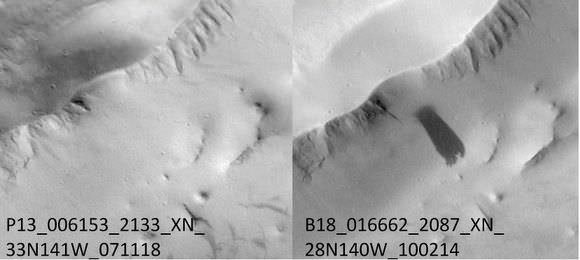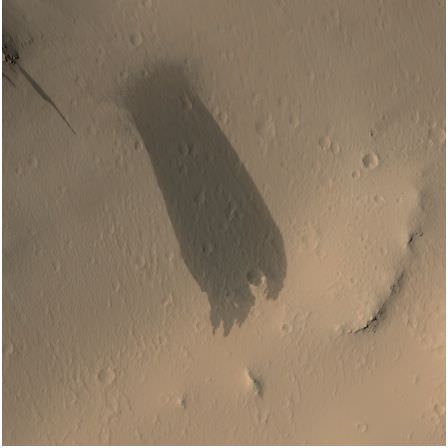[/caption]
The HiRISE team from the Mars Reconnaissance Orbiter has captured a few avalanches on Mars, some actually while in progress. But this latest landslide is a little different. Above is a dust avalanche that created a streak on the slopes of Olympus Mons, the solar system’s largest volcano. While scientists believe some of the previous avalanches seen on Mars occur due to the expansion and contraction of ice from seasonal temperature differences, this one was caused by an impact event. This HiRISE image was taken on March 31, 2010 and reveals a small, pristine impact crater (blue arrow). “It shows a fuzzy source area, which resembles the airblast patterns seen at many other recent impact sites,” said Alfred McEwen, Principal Investigator for HiRISE. “The crater is only about 4.5 meters across, meaning the bolide was only about a half a meter wide, so it didn’t take much to trigger this landslide.”

MRO’s Context Camera (CTX) took an image of this area on Nov. 18, 2007 (left) and the adjacent image on Feb. 14, 2010, which shows a large new avalanche. HiRISE then took the follow-up image in March. McEwen said slope streaks , or dust avalanches are common on Mars, but this one is unusually wide and began from an unusual extended or “fuzzy” source area. This made HiRISE team conclude that an impact event occurred sometime between the dates of the CTX images and triggered the large dust avalanche.
“Sometimes, these dust avalanches are easily triggered,” McEwen told Universe Today. “We’ve seen them caused just by dust devils. The dark area was created by an atmospheric blast associated with the impact event, with the bolide coming in at about 10 km per second that distributes the dust. You can see that the upper most fresh dust on the surface is bright, so this landslide disturbed either bare substrate or compacted, older dust.

Planetary scientists say that landslides or avalanches on Mars can also be caused by small Mars-quakes or the sublimation of carbon dioxide frost which dislodges rocks.
Sources: HiRISE, phone conversation with Alfred McEwen.


HiRise ‘rocks the boat’ once again! Did you notice that the “Dust Avalanches” must be a very thin layer? and fairly easily disturbed – freshly deposited by the wind?
Now this is ridiculous, to have less than half a meter control of some Mars features! R-e-d-i-c-u-o-l-o-u-s, I tell you; that means you can no longer make a parking violation on Mars either.
Has anyone told the rover drivers?
You’re just trying to get Spirit towed, aren’t you, Torbjørn?
That’s a great idea, Sili! Where is the Interstellar Police Patrol when you need them?!
I didn’t see anything in the article that really describes WHY the disturbed soil/regolith is dark in these images…
“You can see that the upper most fresh dust on the surface is bright, so this landslide disturbed either bare substrate or compacted, older dust.”
I am wondering if this is just how the image was taken or if it is some kind of artifact of the colours they chose to generate the image with?
Phillipee, that is an interesting question that I can’t remember seeing an answer to.
I googled around of course, and noticed that THEMIS sees some landslides as dark as well:
“The heat-seeking eye of THEMIS can spot the coarser and rockier portions of a landslide’s debris by their residual warmth, shown in redder tints in the image. Late at night, rocky debris on Mars is still radiating heat absorbed during daytime, just as asphalt pavement does on Earth. At the same time of night, however, patches of ground mantled in dust (shown in bluer tints) have long since cooled off.”
As HiRISE sees NIR in its “red” band, it may be something similar going on, thermal properties of grains/compacted dust vs non-compacted dust. But I hope someone actually knowing will jump into the fray.
Be interesting to note how long this feature remains visible. Estimating dust deposition rates anyone?